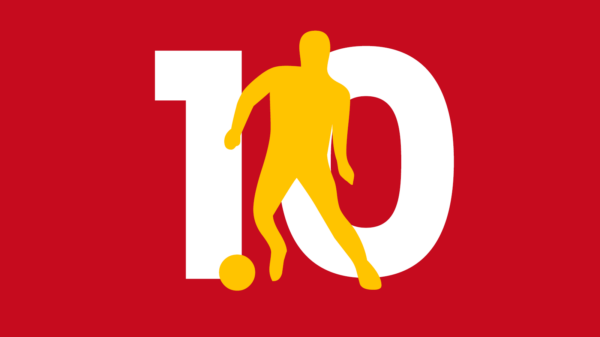Edin Halilovic writes a detailed tactical analysis about the La Liga match that ended Athletic Bilbao 2-2 Atletico Madrid.
Athletic Bilbao hosted Atletico Madrid at San Mames in Round 19 in La Liga, marking the halfway point in the season for both teams with this fixture. European football chasing Athletic went into this match well positioned to push for a top 6 spot and, with a win, could even have entered the argument for the final Champions League position in the league. Atletico, on the other hand, needed a win to keep pace with the three teams in front of them in order to keep their slim title hopes alive and boost their chances of qualifying for Europe’s premier club competition next season automatically as they look to wrestle third place away from overachievers Sevilla.
Early Left Hand Combinations from Atletico
Atletico came out of the blocks quickly in this match, showing a positive intent to go at Athletic from the kick-off and were quickly rewarded with an early goal from a Koke cross that went straight in. They set about trying to create their opportunities through their left hand side with overloading situations up against de Marcos. Filipe’s early forward runs were often left unnoticed which gave Atletico an easy target to play the ball to down that side, mainly through Koke and Saul who rotated in their movements towards the flank and Carrasco, thus creating several different passing angles and allowing Atletico to cause plenty of problems by overloading the left flank in the early stages of the game.
Following their goal and a short period of controlling possession afterward, Atletico began to drop deeper and play more conservatively as Athletic adjusted well to deal with the threat they posed down the left hand side. Although they continued to try and create chances by releasing early balls mainly to Carrasco down that flank on the counter, they weren’t as effective without the added numerical support and thus their attacks died down a lot quicker and they were pinned back on the defensive end from thereon.
Athletic’s Wide-Focused Attacks
Atletico weren’t the only ones looking for success through attacking wide areas in this game. Athletic similarly built their attacking base on playing through the flanks with most of their passes directed towards the players positioned out wide and trying to beat the opposing fullbacks through numerical superiority, combinational play, and by attempting to drag defenders out of position and get in behind them with swift ball and player movement into the spaces left exposed.
However, they initially had problems advancing their build-up plays with sequences of negative U-shape passing occurring particularly in the first half as a result of a bad positional structure. This led to them having to play more counter-productive passes, including long balls as well as horizontal and vertical passes that were often intercepted by Atletico’s midfield bodies.
Athletic predominantly attacked through the left hand side where Atletico were somewhat short-handed defensively due to the lack of support for Vrsaljko from Griezmann who often stayed up front to offer a pacey, secondary forward option on the counter for the visitors who played a 4-4-2 in defense. This left the Croat up against Balenziaga and Lekue who tried to combine and put him under pressure with their numerical presence in attack while the movements into the channels from Muniain and Garcia further created problems for Atleti down that flank. Athletic created the bulk of their opportunities in that manner and playing down that side.
With the numerical support through the overlapping runs of the fullbacks and the movement of the forward players, Athletic were able to successfully draw Atletico players out of position and open up spaces in the channels which they attempted to exploit throughout. Their offensive rotations and movement both on and off the ball allowed them to stretch the visitors defensively and opened up holes in their rearguard, a rarity with this usually disciplined and well organized Simeone-led outfit who tend to be hard to break down.
Athletic’s Formation Switch and Attacking Movement
To deal with their build-up problems, Valverde adjusted Athletic’s tactics midway through the first half by having Iturraspe slot back into central defense, allowing Boveda and Laporte to play wider and the two fullbacks to push higher up the field to form a 3-4-3 in possession. This created better spacing and provided more depth for Athletic’s passing game which allowed them to progress the play forward more effectively and successfully.
Another reason for their improvement on the offensive end was the attacking movement of the quartet of Williams, Lekue, Garcia, and Muniain, particularly the latter, who managed to find pockets of space in between the lines and receive the ball in good positions to drive at Atletico defenders as a means of breaking past them. Muniain was at the center of all things good for Athletic from an attacking perspective as he instigated several good openings with his passing and dribbling which complimented his smart off-the-ball movement. The Spaniard took the attentions of several Atletico players and freed up his teammates on the opposite side.
The change not only refined Athletic’s build-up structure which allowed for smoother forward ball circulation, but also allowed more freedom for the offensive players to move and search for spaces which Atletico were uncharacteristically giving away due to their lack of vertical compactness between the defense and midfield. As Atleti tilted their shape towards the direction of the ball, which was often moving towards the wider positioned players, this created room for the likes of Muniain, Garcia, and Williams to maneuver into with their intelligent movements and positional alternations where they were able to receive the ball consistently. This occurred whenever the circulation and switch play of the deeper or wider players was turned up a notch, giving Atletico lesser recovery time to settle back into their normal shape.
Atletico’s Changes
After falling behind early in the second half, Simeone rolled the dice and rang all three changes within several minutes. He first brought on Torres for Gabi which allowed Atletico to have two out-and-out center forwards up front with the Spaniard pairing with Gameiro. This allowed Griezmann to move out wide to the right flank but with more freedom to move inside and offer a more central presence as the link between the midfield and the forwards. He then brought on Correa and Gaitan for Gameiro and Carrasco who had unconvincing displays.
They ended up continuing to fluctuate between 4-4-2/4-2-4 and 4-3-3 with Gaitan, Griezmann, and Correa roaming freely around the final third of the pitch and often interchanging positionally. They also began to attack more through the right hand side by making more use of Vrsaljko’s overlapping runs in 1v1 situations against Balenziaga with the support of Griezmann and Gameiro who made more runs into the channels than he did in the first 45 minutes.
These very offensive changes created an imbalance and disconnect in Atletico’s structure which led to problems in building plays from out of the back, partially due to the unsuited personnel at the back with Gimenez and Godin neither being comfortable enough on the ball. This meant that Koke and Saul both had to drop deeper to offer close range passing options and take on the build-up responsibilities, which created a disconnection between the midfield and the attack as they moved to operate in a deeper zone closer to the central defenders while the rest of the team was moving further forward.
This left Atletico in a conundrum when it came to advancing the ball into forward areas as they lacked basic positional structure and had to resort to riskier passing play in possession. They weren’t set up properly to play through Athletic with shorter ball circulation due to the sheer amount of offensive minded personnel on the pitch. Inevitably, it led to several turnovers for Atletico in possession as Athletic were able to create more on the counter than they were in the first half but they ended up failing to take their chances which they would rue by the end of the game as Atletico equalized late through a sweet Griezmann strike from outside the penalty area ten minutes from time.
Conclusion
Both teams adjusted their problems and rallied well when encountered with setbacks, but neither was able to grab a winner in the end as the game finished honors even. Athletic’s improvements were canceled out by Atletico’s potent individual quality up front as neither side really moved any closer to their aspired targets with the draw. While Athletic remained positioned well enough to keep fighting for Europe, Atletico can all but kiss their title dreams goodbye and may have a real stern ride ahead of them to ensure that they’ll play Champions League football for the fifth consecutive campaign next term.
Read all our tactical analyses here
- Tactical Analysis: Athletic Bilbao 2-2 Atletico Madrid | All square at San Mames - February 3, 2017
- Scout Report: Gabriel Jesus | Manchester City’s new Brazilian starlet - January 5, 2017
- Tactical Analysis: Bayern Munich 1-1 Hoffenheim | Sinsheim club remain unbeaten - November 15, 2016































































